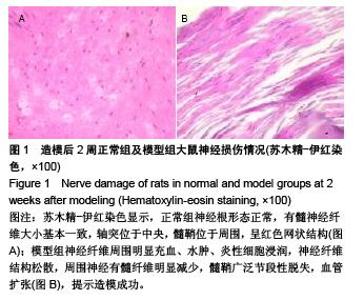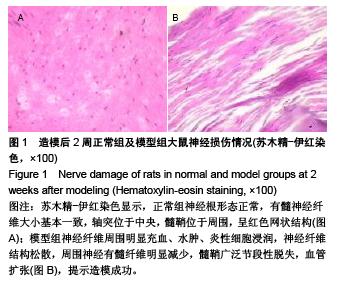Chinese Journal of Tissue Engineering Research ›› 2015, Vol. 19 ›› Issue (49): 7878-7878.doi: 10.3969/j.issn.2095-4344.2015.49.001
Effect of warm needling on histomorphology of compressed lumbar nerve root in rats
Xie Yan-yan1, Wu Yao-chi2
- 1Department of Acupuncture Traumatology, Eastern Hospital of Shanghai Sixth People’s Hospital, Shanghai 201306, China; 2Department of Acupuncture Traumatology, the Sixth People’s Hospital, Shanghai Jiao Tong University, Shanghai 200233, China
-
Received:2015-09-07Online:2015-11-30Published:2015-11-30 -
Contact:Wu Yao-chi, Professor, Doctoral supervisor, Chief physician, Department of Acupuncture Traumatology, the Sixth People’s Hospital, Shanghai Jiao Tong University, Shanghai 200233, China -
About author:Xie Yan-yan, Master, Attending physician, Department of Acupuncture Traumatology, Eastern Hospital of Shanghai Sixth People’s Hospital, Shanghai 201306, China -
Supported by:a grant from Shanghai Science and Technology Commission of China, No. 04419723
CLC Number:
Cite this article
Xie Yan-yan, Wu Yao-chi. Effect of warm needling on histomorphology of compressed lumbar nerve root in rats[J]. Chinese Journal of Tissue Engineering Research, 2015, 19(49): 7878-7878.
share this article
| [1] 胡有谷.腰椎间盘突出症(第3版)[M].北京:人民卫生出版社,2004:46. [2] 安胜军,李恩.人类椎间盘退变与年龄的关系[J].中国矫形外科杂志,2000,7(4):379-381. [3] 李宗发.腰椎间盘突出症的非手术治疗综述[J].中国医药指南, 2011,9(32):281-282. [4] 宓轶群,吴耀持,陈一.温针灸对大鼠腰神经根受压模型炎性介质NOS和CGRP调节作用的研究[J].中国针灸,2009,29(1):48-52. [5] 张峻峰,吴耀持.腰神经根受压模型大鼠神经根局部炎症因子对温和灸的反应[J].中国组织工程研究与临床康复,2007,11(45): 9129-9132. [6] 吴耀持,张彩虹.针刺对腰神经根压迫症模型大鼠受损腰神经根超微结构及炎性介质的影响[J].上海针灸,2003,22(9): 1653-1656. [7] Siegal T, Siegal TZ, Shapira Y, et al. Indomethacin and dexam ethasone treatment in experimental neoplastic spinal cord compression: Part 1: Effect on water content and specific gravity. Neurosurgery. 1988;22(2):328-333. [8] 刘进显,黎尚荣.大鼠腰神经根受压模型建立的实验研究[J].现代医院,2010;10(5):23-24. [9] 吴耀持,孙懿君,张峻峰,等,电针对腰神经根受压兔肌肉状态及坐骨神经运动传导速度的影响[J].中国针灸,2011,31(11):1009- 1013. [10] 郎园园,侯书伟.针刺治疗腰椎间盘突出症取穴现状[J].山东中医药大学学报, 2010, 34(1):95-96. [11] Wu YC, Zhang JF, Wang CM, et al. Acupuncture at the “Huatuojiaji” point affects nerve root regional interleukin-1 level in a rat model of lumbar nerve root compression. Neural Regen Res. 2008;3(8):881-884. [12] 李具宝,熊启良,屈尚可,等,近10年针灸治疗腰椎间盘突出症选穴规律的探讨[J]. 中国针灸,2013,33(7):668-672. [13] Mixtter WJ,Barr JS.Rupture of the intervertebral disc with involvement of the spinal canal.N England J Med. 1934; 211: 210-215. [14] Roberts S,Caterson B,Menage J,et al.Matrix metalloproteinasea and aggrecanase their role in disorders of the human intervertebraldisc.Spine. 2000;25(23):3005-3013. [15] Ansa R,Tajima N,Chosa E, et al. Biochemical and morphological changes in herniated human intervertebral disc. Orthop Sci. 2001;6(6):510-518. [16] Saal JS,Franson RC,Dobrow R,et al. High levels of inflammatory phospholipase A activity in lumbar disc hernaition. Spine. 1990;15:674-678. [17] Ozaktay AC, Cavanaugh JM, Blagove DC. Phospholipase A induced eletrophysiologic and histologic changes in rabbit dorsal lumbar spine tissues.Spine. 1995;20:2659-2668. [18] Chen C,Cavanavgh JM, Ozaktay AC, et al. Efects of phospholipase on lumbar nerver root structure and function. Spine. 1997;22:1057-1064. [19] 谢艳艳,吴耀持.温针对大鼠腰神经根受压模型中PLA2的影响[J].上海针灸杂志,2011,30(9):631-633. [20] O′Donnell JL,O′Donnell AL.Protaglandin E2 content in hernitated lumbar disc disease.Spine. 1996;21:1653-1656. [21] 谢艳艳,吴耀持.温针对大鼠腰神经根受压模型中PGE2的调节作用[J].中国组织工程与研究,2012,16(37):6951-6955. [22] 郑力峰,叶君健. MCP-1在腰椎间盘突出症髓核中的表达及临床意义[J].基础医学与临床,2011,31(2):139-143. [23] 史红伟,关晓明,马迅. TNF-a诱导大鼠髓核细胞凋亡过程中EMP-1和Caspase-3mRNA基因表达及意义[J]. 长治医学院学报,2014,28(1):1-5. [24] 徐贵锋,高令军.电针对盘源性神经根损伤保护机制的实验研究[J].上海中医药大学学报,2015,29(3):81-85. [25] 杨宗保,易受乡,封迎帅,等.电针环跳穴对腰椎间盘突出症家兔髓核组织PGE2、PLA2和IL-1α的影响[J]. 中华中医药杂志, 2012, 27(3):576-578. [26] 杨宗保,封迎帅,易受乡,等.电针环跳穴对腰椎间盘突出症坐骨神经损伤修复的实验研究[J]. 中华中医药杂志,2012,27(1): 199-201. [27] 李松军,邝立鹏,王兆杰,等. 腰间盘HIZ与TNF a表达的相关性研究及其在椎间盘内破裂症中的诊断价值[J].中国医学创新, 2014, 11(6):46-48. [28] 彭丽辉,陈剑明,王颖,等. 用温针灸夹脊穴法治疗腰椎间盘突出症的疗效与血浆β-内啡肽的水平相关性的分析[J]. 求医问药, 2013,11(11):122-123. [29] 黄承飞,吴耀持.针灸治疗腰椎间盘突出症局部炎症作用机制的研究进展[J],湖南中医杂志,2012,28(4):171-174. [30] 吴耀持,张彩虹.针刺对腰神经根压迫症模型大鼠受损腰神经根超微结构及炎性介质的影响[J].上海针灸,2003, 22(9): 1653-1656. [31] 焦旭文,王国平,李军平,等.EPO对大鼠腰神经根慢性压迫性损伤的保护作用[J].宁夏医科大学学报,2013,35(11):1199-1202. [32] 徐乐勤,张有为,李晓锋,等.益气化瘀方对腰神经根压迫模型大鼠神经根组织Bax和Bcl-2 的表达影响[J].中国中医骨伤科杂志, 2011,19(4):1-4. [33] Olmarker K,Rydevik B,Holm S. Edema formation in spinal nerve roots induced by experimental graded compression: an experimentalstudy on the pig cauda equine with special reference to differences in effects between rapid and slow onset of compression. Spine. 1989;14(6):569. [34] 岳寿伟,吴宗耀,徐淑军,等.兔腰神经根慢性压迫模型的建立[J].中国康复医学杂志,2002,17(4) : 205-207. [35] Hu SJ,Xing JL. An experimental model for chronic compression of dorsal root ganglion produced by intervertebral foramen stenosis in the rat.Pain. 1998;77: 15-23. [36] 焦旭文,马宁,李军平,等 NGF对腰神经根慢性压迫性模型大鼠脊髓神经细胞凋亡的影响[J].宁夏医学杂志, 2013,35(11): 1012-1015. [37] Cornefjord M, Satok O, Lmarker K, et al. A model for chronic never root compression studies: Presentation of a Porcine Model for Control led, Slow - Onset Comp ression With Analyses of Anatom ic Aspects, Compression On set Rate, and Morphologic and Neurophysiologic Effects. Spine. 1997; 22(9): 946-957. [38] Toh E, Mochida J. Histologic analysis of the lumbosacral nerve roots after compression in young and aged rabbits. Spine. 1997;22(7): 721-726. [39] 王拥军,万超.实验性腰神经根压迫的模型建立[J].中国中医骨伤科杂志, 1999, 7(1): 9-12. [40] 吴曦,刘凤阁.腰椎间盘突出症模型研究进展[J].山西医药杂志. 2012,41(3):247-249. |
| [1] | Chen Ziyang, Pu Rui, Deng Shuang, Yuan Lingyan. Regulatory effect of exosomes on exercise-mediated insulin resistance diseases [J]. Chinese Journal of Tissue Engineering Research, 2021, 25(25): 4089-4094. |
| [2] | Chen Yang, Huang Denggao, Gao Yuanhui, Wang Shunlan, Cao Hui, Zheng Linlin, He Haowei, Luo Siqin, Xiao Jingchuan, Zhang Yingai, Zhang Shufang. Low-intensity pulsed ultrasound promotes the proliferation and adhesion of human adipose-derived mesenchymal stem cells [J]. Chinese Journal of Tissue Engineering Research, 2021, 25(25): 3949-3955. |
| [3] | Yang Junhui, Luo Jinli, Yuan Xiaoping. Effects of human growth hormone on proliferation and osteogenic differentiation of human periodontal ligament stem cells [J]. Chinese Journal of Tissue Engineering Research, 2021, 25(25): 3956-3961. |
| [4] | Sun Jianwei, Yang Xinming, Zhang Ying. Effect of montelukast combined with bone marrow mesenchymal stem cell transplantation on spinal cord injury in rat models [J]. Chinese Journal of Tissue Engineering Research, 2021, 25(25): 3962-3969. |
| [5] | Gao Shan, Huang Dongjing, Hong Haiman, Jia Jingqiao, Meng Fei. Comparison on the curative effect of human placenta-derived mesenchymal stem cells and induced islet-like cells in gestational diabetes mellitus rats [J]. Chinese Journal of Tissue Engineering Research, 2021, 25(25): 3981-3987. |
| [6] | Hao Xiaona, Zhang Yingjie, Li Yuyun, Xu Tao. Bone marrow mesenchymal stem cells overexpressing prolyl oligopeptidase on the repair of liver fibrosis in rat models [J]. Chinese Journal of Tissue Engineering Research, 2021, 25(25): 3988-3993. |
| [7] | Liu Jianyou, Jia Zhongwei, Niu Jiawei, Cao Xinjie, Zhang Dong, Wei Jie. A new method for measuring the anteversion angle of the femoral neck by constructing the three-dimensional digital model of the femur [J]. Chinese Journal of Tissue Engineering Research, 2021, 25(24): 3779-3783. |
| [8] | Meng Lingjie, Qian Hui, Sheng Xiaolei, Lu Jianfeng, Huang Jianping, Qi Liangang, Liu Zongbao. Application of three-dimensional printing technology combined with bone cement in minimally invasive treatment of the collapsed Sanders III type of calcaneal fractures [J]. Chinese Journal of Tissue Engineering Research, 2021, 25(24): 3784-3789. |
| [9] | Qian Xuankun, Huang Hefei, Wu Chengcong, Liu Keting, Ou Hua, Zhang Jinpeng, Ren Jing, Wan Jianshan. Computer-assisted navigation combined with minimally invasive transforaminal lumbar interbody fusion for lumbar spondylolisthesis [J]. Chinese Journal of Tissue Engineering Research, 2021, 25(24): 3790-3795. |
| [10] | Hu Jing, Xiang Yang, Ye Chuan, Han Ziji. Three-dimensional printing assisted screw placement and freehand pedicle screw fixation in the treatment of thoracolumbar fractures: 1-year follow-up [J]. Chinese Journal of Tissue Engineering Research, 2021, 25(24): 3804-3809. |
| [11] | Shu Qihang, Liao Yijia, Xue Jingbo, Yan Yiguo, Wang Cheng. Three-dimensional finite element analysis of a new three-dimensional printed porous fusion cage for cervical vertebra [J]. Chinese Journal of Tissue Engineering Research, 2021, 25(24): 3810-3815. |
| [12] | Wang Yihan, Li Yang, Zhang Ling, Zhang Rui, Xu Ruida, Han Xiaofeng, Cheng Guangqi, Wang Weil. Application of three-dimensional visualization technology for digital orthopedics in the reduction and fixation of intertrochanteric fracture [J]. Chinese Journal of Tissue Engineering Research, 2021, 25(24): 3816-3820. |
| [13] | Sun Maji, Wang Qiuan, Zhang Xingchen, Guo Chong, Yuan Feng, Guo Kaijin. Development and biomechanical analysis of a new anterior cervical pedicle screw fixation system [J]. Chinese Journal of Tissue Engineering Research, 2021, 25(24): 3821-3825. |
| [14] | Lin Wang, Wang Yingying, Guo Weizhong, Yuan Cuihua, Xu Shenggui, Zhang Shenshen, Lin Chengshou. Adopting expanded lateral approach to enhance the mechanical stability and knee function for treating posterolateral column fracture of tibial plateau [J]. Chinese Journal of Tissue Engineering Research, 2021, 25(24): 3826-3827. |
| [15] | Zhu Yun, Chen Yu, Qiu Hao, Liu Dun, Jin Guorong, Chen Shimou, Weng Zheng. Finite element analysis for treatment of osteoporotic femoral fracture with far cortical locking screw [J]. Chinese Journal of Tissue Engineering Research, 2021, 25(24): 3832-3837. |
| Viewed | ||||||
|
Full text |
|
|||||
|
Abstract |
|
|||||

